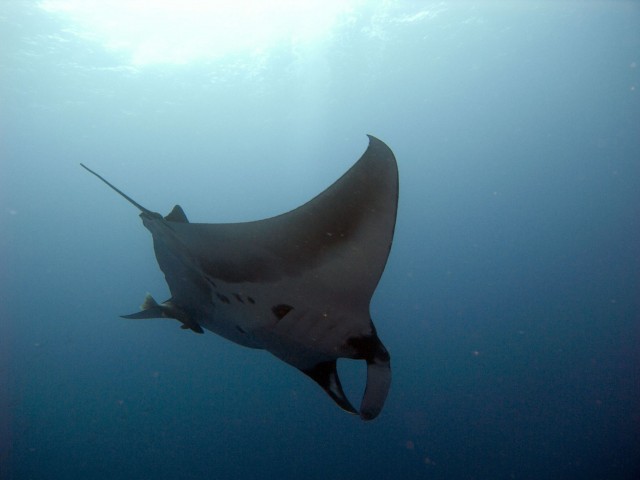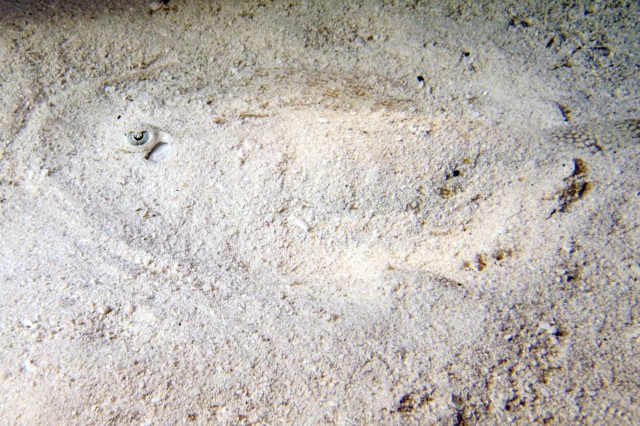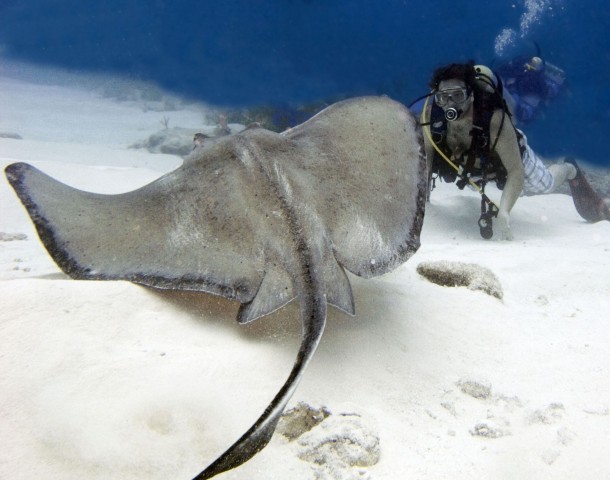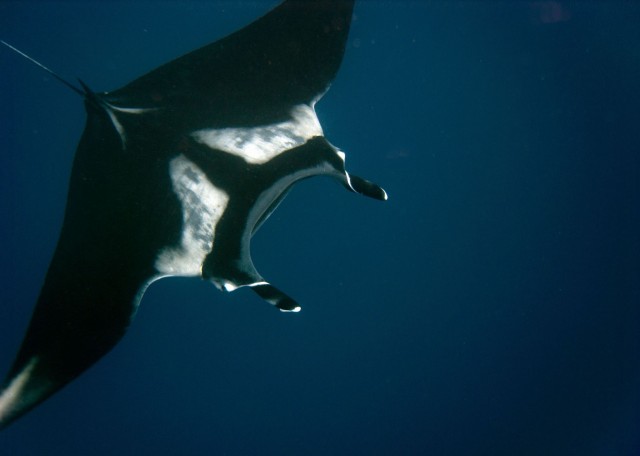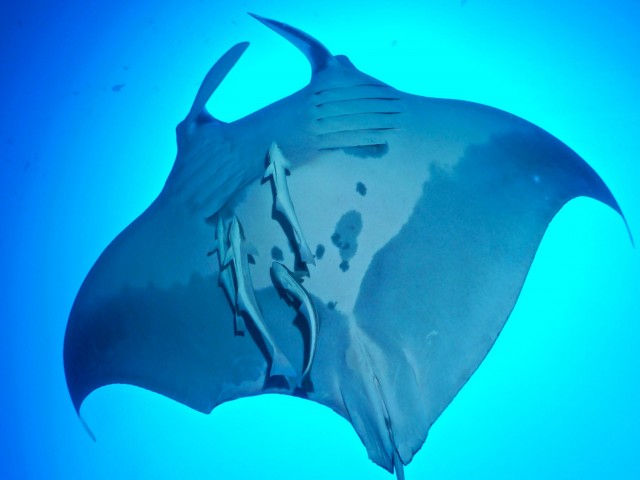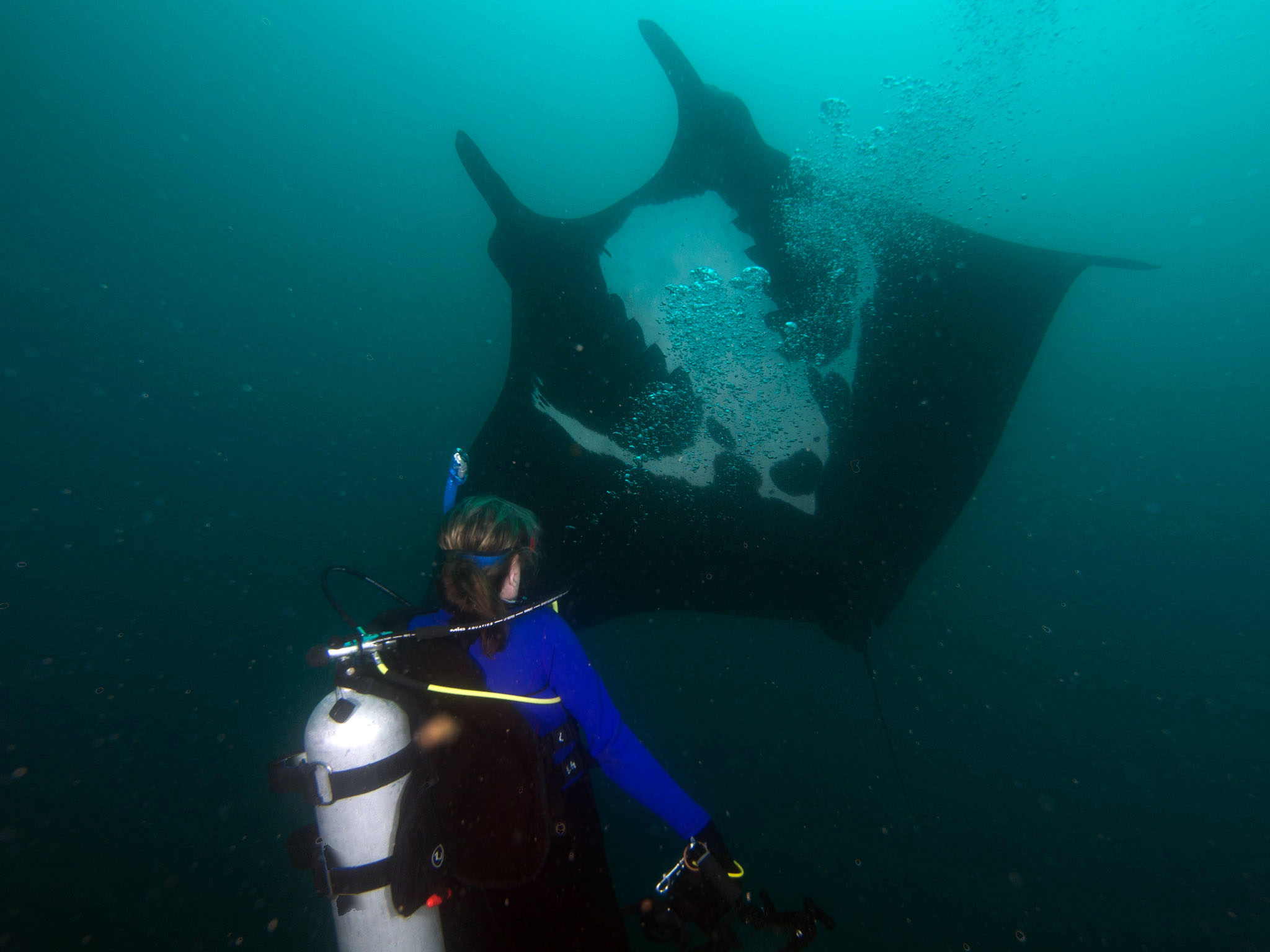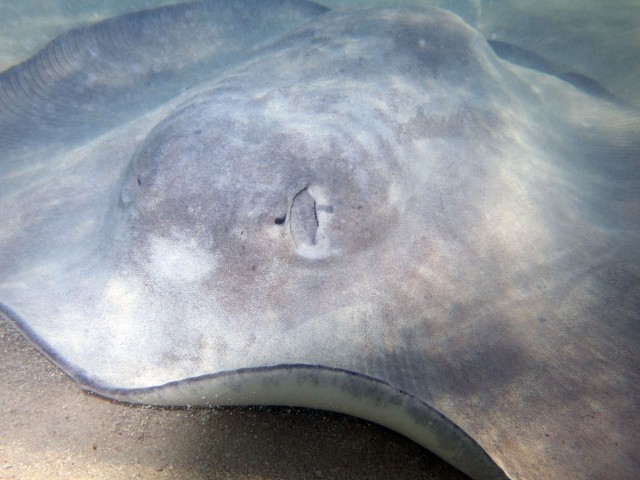Marine Life & Conservation Blogs
My Love of Rays
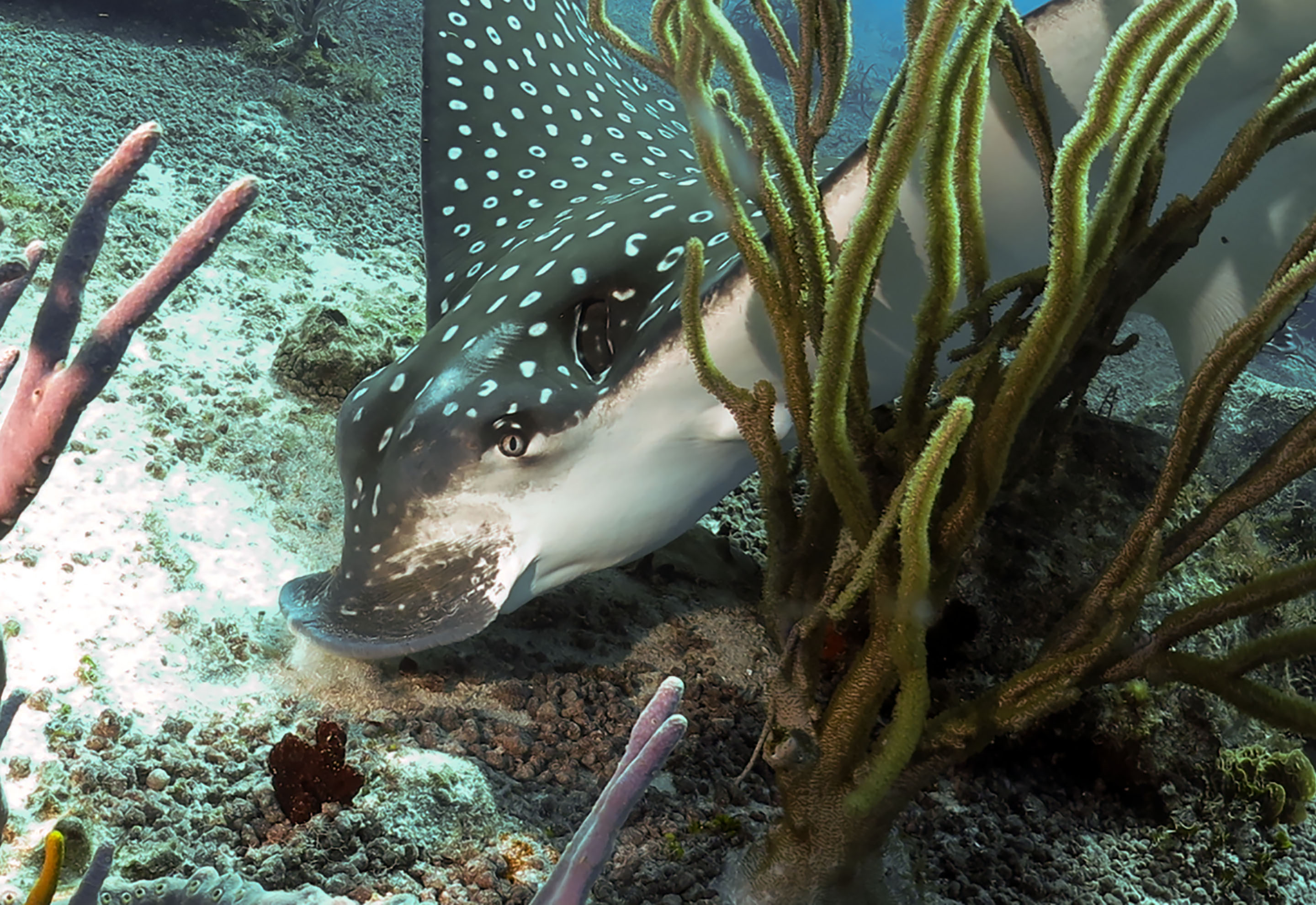
I love everything in the ocean. Really. But I do have to confess to a very special feeling for rays. Stingrays, Eagle Rays, Manta Rays… they are breathtaking to watch, and I get excited every single time I see one. My love of the ocean I credit to my parents, as they took my brother and I to Florida every year for at least two weeks during my childhood. My love of marine animals began with Jacques Cousteau, who introduced me, through his tv specials, to a mysterious underwater realm with incredible, colorful creatures. As a child, I watched spellbound. Sincerely, the ocean and its inhabitants make me happy, fill me with childlike wonder, and I can never, never get enough. I love to photograph them (even though I am strictly an amateur).
The first experience I ever had with rays was with Manta Rays. They were seen every summer off of Ft Lauderdale, Florida, and we were called out of the water immediately when they were sighted. I remember looking through the binoculars at a “devilfish” I found enthralling and graceful, though I was told they would “eat” me. As I began snorkeling and diving as a young adult, whenever a ray came near I was mesmerized. They fly through the water with graceful, undulating wings (flaps), and I have always found them beautiful. I love coming across them when they are buried in the sand, with just their eyes and spiracles visible. What a great photo that makes!
When our children were small, we took them to the Cayman Islands several times. Of course we went to Stingray City. I went to Stingray City when I was pregnant, both times actually, and snorkeled above my husband while he was covered in Southern Sting Rays. They feel so very soft, especially underneath. Like velvet. Stingray City was every bit as much for me as the kids; it always amazed me, to snorkel, float, or to stand near so many beautiful rays.
I saw my first Eagle Ray in Cozumel, and I was so excited I could barely breathe. Eagles are big and glorious as they fly through the water, and have “cheerios” markings. They all fascinate me, from the small Yellow Rays to the Southern Stingrays, to the Eagles, the blue spotted, and the Queen of them all, the Manta.
Seeing many new rays in Africa, I only saw two Mantas! Only two. Actually, my diving in Tofo was disappointing to me, but perhaps it was just the wrong season. For whatever reason, my visions of being surrounded by Manta Rays while diving did not materialize, at least not in Tofo. I did see Blue Spotted Rays, a Torpedo Electric Ray, one Mobula, a Jenkins Whiptail and a Honeycombed Whiptail, but I never saw the rare Small-Eye Stingray. I enjoyed seeing new and different rays, though.
My desire for Manta Ray encounters continued, and I finally achieved a dive trip where I saw several Giant Mantas, Black Pacific Mantas, Reef Mantas… it is almost indescribable, diving with these curious, beautiful, mysterious giants. You can tell from their eyes that they are intelligent; you know they are “checking” you out. I took a million photos, and each dive was more thrilling than the next… rays and sharks! What could be better? That was our trip on the Solmar V to the Revillagigedos Islands… I want to do that again! I turned my photos over to the Pacific Manta Research Group, and I photographed one they hadn’t seen in 10 years! They graciously allowed me to name it, so I named it Jedi. May the force be with you.
On Stocking Island in the Exumas, Bahamas, rays swarm the beach. AJ, the conch man, has been giving them scraps of conch for years and they gladly swim all over you in search of it! I loved feeding them, touching them, and taking pictures. One of the rays was different, definitely NOT a Southern Stingray as the rest of them were. It felt sandy on top, not soft, and had very small eyes with a large head and thick tail. I’d never seen it before. After a few days of research I found my ray: the Caribbean Whip Tail Ray! I had never even heard of it. I’m always excited when I see a new animal!
And the epitome of my Manta Ray diving so far has been a Citizen Science trip I went on with Marine Megafauna Ecuador. Hundreds of them! I was in heaven! It is essential that we help these creatures; Mantas are endangered. The Marine Megafauna Foundation works very hard, as do other great organizations, to change that. I urge you to take a look at their website and learn about these amazing creatures. I adopted a Manta and named her Daenarys Targareon, from Game of Thrones. Adopting a ray or a whale shark helps to protect these animals from extinction, and ending up in Chinese medicine and Shark Fin Soup. I urge you to visit them at www.marinemegafauna.org. You will fall in love! I certainly did.
For more from Tam, visit www.travelswithtam.com.
Marine Life & Conservation Blogs
Creature Feature: Dusky Shark

 In this series, the Shark Trust will be sharing amazing facts about different species of sharks and what you can do to help protect them.
In this series, the Shark Trust will be sharing amazing facts about different species of sharks and what you can do to help protect them.
This month we’re taking a look at the Dusky Shark, a highly migratory species with a particularly slow growth rate and late age at maturity.
Dusky sharks are one of the largest species within the Carcharhinus genus, generally measuring 3 metres total length but able to reach up to 4.2 metres. They are grey to grey-brown on their dorsal side and their fins usually have dusky margins, with the darkest tips on the caudal fin.
Dusky Sharks can often be confused with other species of the Carcharhinus genus, particularly the Galapagos Shark (Carcharhinus galapagensis). They have very similar external morphology, so it can be easier to ID to species level by taking location into account as the two species occupy very different ecological niches – Galapagos Sharks prefer offshore seamounts and islets, whilst duskies prefer continental margins.
Hybridisation:
A 2019 study found that Dusky Sharks are hybridising with Galapagos Sharks on the Eastern Tropical Pacific (Pazmiño et al., 2019). Hybridisation is when an animal breeds with an individual of another species to produce offspring (a hybrid). Hybrids are often infertile, but this study found that the hybrids were able to produce second generation hybrids!
Long distance swimmers:
Dusky sharks are highly mobile species, undertaking long migrations to stay in warm waters throughout the winter. In the Northern Hemisphere, they head towards the poles in the summer and return southwards towards the equator in winter. The longest distance recorded was 2000 nautical miles!
Very slow to mature and reproduce:
The Dusky Shark are both targeted and caught as bycatch globally. We already know that elasmobranchs are inherently slow reproducers which means that they are heavily impacted by overfishing; it takes them so long to recover that they cannot keep up with the rate at which they are being fished. Dusky Sharks are particularly slow to reproduce – females are only ready to start breeding at roughly 20 years old, their gestation periods can last up to 22 months, and they only give birth every two to three years. This makes duskies one of the most vulnerable of all shark species.
The Dusky Shark is now listed on Appendix II of the Convention on the Conservation of Migratory Species (CMS), but further action is required to protect this important species.
Scientific Name: Carcharhinus obscurus
Family: Carcharhinidae
Maximum Size: 420cm (Total Length)
Diet: Bony fishes, cephalopods, can also eat crustaceans, and small sharks, skates and rays
Distribution: Patchy distribution in tropical and warm temperate seas; Atlantic, Indo-Pacific and Mediterranean.
Habitat: Ranges from inshore waters out to the edge of the continental shelf.
Conservation status: Endangered.
For more great shark information and conservation visit the Shark Trust Website
Images: Andy Murch
Diana A. Pazmiño, Lynne van Herderden, Colin A. Simpfendorfer, Claudia Junge, Stephen C. Donnellan, E. Mauricio Hoyos-Padilla, Clinton A.J. Duffy, Charlie Huveneers, Bronwyn M. Gillanders, Paul A. Butcher, Gregory E. Maes. (2019). Introgressive hybridisation between two widespread sharks in the east Pacific region, Molecular Phylogenetics and Evolution 136(119-127), https://doi.org/10.1016/j.ympev.2019.04.013.
Marine Life & Conservation Blogs
Creature Feature: Undulate Ray

 In this series, the Shark Trust will be sharing amazing facts about different species of sharks and what you can do to help protect them.
In this series, the Shark Trust will be sharing amazing facts about different species of sharks and what you can do to help protect them.
This month we’re looking at the Undulate Ray. Easily identified by its beautiful, ornate pattern, the Undulate Ray gets its name from the undulating patterns of lines and spots on its dorsal side.
This skate is usually found on sandy or muddy sea floors, down to about 200 m deep, although it is more commonly found shallower. They can grow up to 90 cm total length. Depending on the size of the individual, their diet can range from shrimps to crabs.
Although sometimes called the Undulate Ray, this is actually a species of skate, meaning that, as all true skates do, they lay eggs. The eggs are contained in keratin eggcases – the same material that our hair and nails are made up of! These eggcases are also commonly called mermaid’s purses and can be found washed up on beaches all around the UK. If you find one, be sure to take a picture and upload your find to the Great Eggcase Hunt – the Shark Trust’s flagship citizen science project.
It is worth noting that on the south coasts, these eggcases can be confused with those of the Spotted Ray, especially as they look very similar and the ranges overlap, so we sometimes informally refer to them as ‘Spundulates’.
Scientific Name: Raja undulata
Family: Rajidae
Maximum Size: 90cm (total length)
Diet: shrimps and crabs
Distribution: found around the eastern Atlantic and in the Mediterranean Sea.
Habitat: shelf waters down to 200m deep.
Conservation Status : As a commercially exploited species, the Undulate Ray is a recovering species in some areas. The good thing is that they have some of the most comprehensive management measures of almost any elasmobranch species, with both minimum and maximum landing sizes as well as a closed season. Additionally, targeting is entirely prohibited in some areas. They are also often caught as bycatch in various fisheries – in some areas they can be landed whilst in others they must be discarded.
IUCN Red List Status: Endangered
For more great shark information and conservation visit the Shark Trust Website
Image Credits: Banner – Sheila Openshaw; Illustration – Marc Dando
-

 News3 months ago
News3 months agoHone your underwater photography skills with Alphamarine Photography at Red Sea Diving Safari in March
-

 News3 months ago
News3 months agoCapturing Critters in Lembeh Underwater Photography Workshop 2024: Event Roundup
-

 Marine Life & Conservation Blogs3 months ago
Marine Life & Conservation Blogs3 months agoCreature Feature: Swell Sharks
-

 Blogs2 months ago
Blogs2 months agoMurex Resorts: Passport to Paradise!
-

 Blogs2 months ago
Blogs2 months agoDiver Discovering Whale Skeletons Beneath Ice Judged World’s Best Underwater Photograph
-

 Gear Reviews2 weeks ago
Gear Reviews2 weeks agoGEAR REVIEW – Revolutionising Diving Comfort: The Sharkskin T2 Chillproof Suit
-

 Marine Life & Conservation2 months ago
Marine Life & Conservation2 months agoSave the Manatee Club launches brand new webcams at Silver Springs State Park, Florida
-

 Gear Reviews3 months ago
Gear Reviews3 months agoGear Review: Oceanic+ Dive Housing for iPhone


